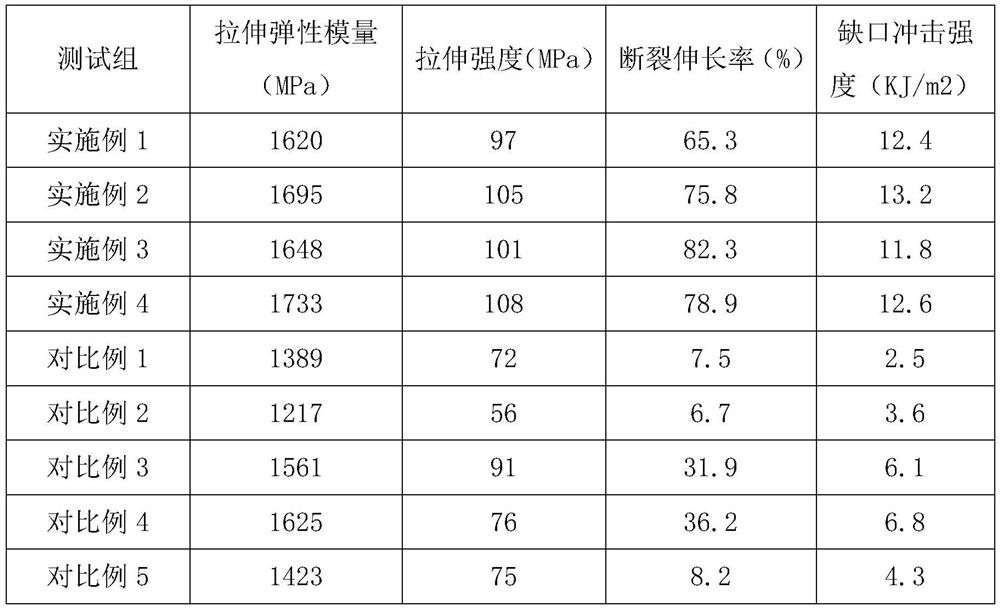Preparation method of carbon fiber reinforced polylactic acid 3D printing material
A 3D printing and carbon fiber technology, applied in the polymer field, can solve the problems of low crystallinity of polylactic acid, long molding cycle, and difficult molding, and achieve the effect of improving comprehensive mechanical properties, improving polarity, and improving mechanical properties.
- Summary
- Abstract
- Description
- Claims
- Application Information
AI Technical Summary
Problems solved by technology
Method used
Image
Examples
Embodiment 1
[0031] A method for preparing a carbon fiber reinforced polylactic acid 3D printing material, specifically, comprising the following steps:
[0032] (1) After soaking and cleaning the carbon fiber in 5% hydrogen peroxide solution for 30 minutes, take it out, clean it with clean water, filter and dry it, and place the carbon fiber in a low-temperature plasma instrument for surface treatment;
[0033] (2) adding the surface-treated carbon fiber and sodium lauryl sulfate equivalent to 3% by weight in acetone, and ultrasonically dispersing for 20 minutes to obtain a carbon fiber dispersion;
[0034] (3) After adding maleic anhydride to the carbon fiber dispersion, heat up to 40 degrees Celsius, stir and mix at 500 rpm for 100 minutes, wash and dry the filter layer, add styrene and initiator to it, and mix well, Raise the temperature to 80 degrees Celsius, react for 3-4 hours, filter, wash repeatedly, and dry in an oven to obtain modified carbon fibers;
[0035] (4) in natural rub...
Embodiment 2
[0047] A method for preparing a carbon fiber reinforced polylactic acid 3D printing material, specifically, comprising the following steps:
[0048] (1) After soaking and cleaning the carbon fiber in 10% hydrogen peroxide solution for 30 minutes, take it out, clean it with clean water, filter and dry it, and place the carbon fiber in a low-temperature plasma instrument for surface treatment;
[0049] (2) adding the surface-treated carbon fiber and sodium lauryl sulfate equivalent to 5% by weight in acetone, and ultrasonically dispersing for 40 minutes to obtain a carbon fiber dispersion;
[0050] (3) After adding maleic anhydride to the carbon fiber dispersion, heat up to 60 degrees Celsius, stir and mix at a speed of 800 rpm for 150 minutes, after the filter layer is washed and dried, add styrene and initiator to it, and mix well After that, heat up to 90 degrees Celsius, react for 4 hours, filter, wash repeatedly, and dry in an oven to obtain modified carbon fibers;
[0051...
Embodiment 3
[0063] A method for preparing a carbon fiber reinforced polylactic acid 3D printing material, specifically, comprising the following steps:
[0064] (1) After soaking and cleaning the carbon fiber in 8% hydrogen peroxide solution for 30 minutes, take it out, clean it with clean water, filter and dry it, and place the carbon fiber in a low-temperature plasma apparatus for surface treatment;
[0065] (2) adding the surface-treated carbon fiber and sodium lauryl sulfate equivalent to 3.8% of its weight in acetone, and ultrasonically dispersing it for 29 minutes to obtain a carbon fiber dispersion;
[0066] (3) After adding maleic anhydride to the carbon fiber dispersion, heat up to 55 degrees Celsius, stir and mix at a speed of 620 rpm for 135 minutes, wash and dry the filter layer, add styrene and initiator to it, and mix well After that, the temperature was raised to 86 degrees Celsius, reacted for 3.4 hours, filtered, washed repeatedly, and dried in an oven to obtain modified ...
PUM
 Login to View More
Login to View More Abstract
Description
Claims
Application Information
 Login to View More
Login to View More - R&D
- Intellectual Property
- Life Sciences
- Materials
- Tech Scout
- Unparalleled Data Quality
- Higher Quality Content
- 60% Fewer Hallucinations
Browse by: Latest US Patents, China's latest patents, Technical Efficacy Thesaurus, Application Domain, Technology Topic, Popular Technical Reports.
© 2025 PatSnap. All rights reserved.Legal|Privacy policy|Modern Slavery Act Transparency Statement|Sitemap|About US| Contact US: help@patsnap.com

